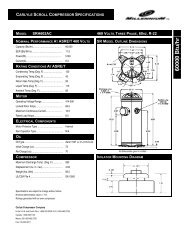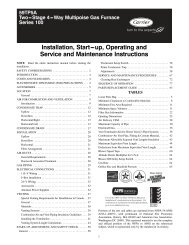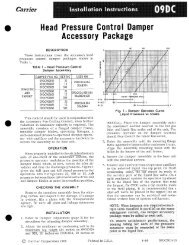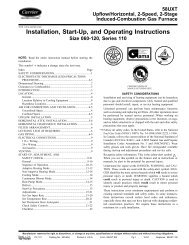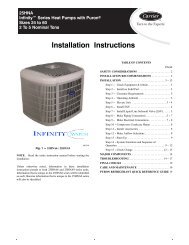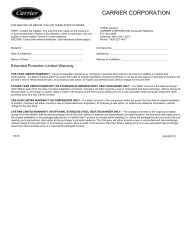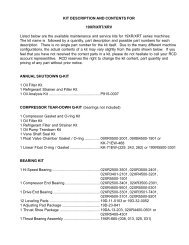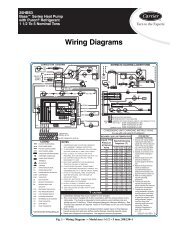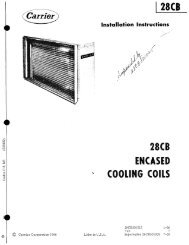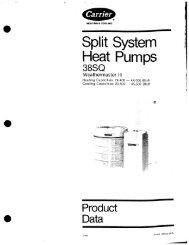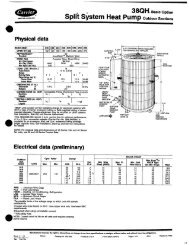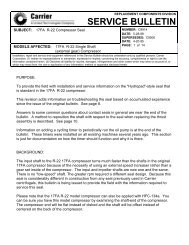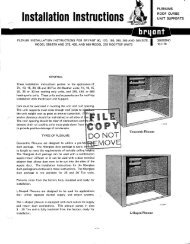Controls, Start-Up, Operation, Service And Troubleshooting - Carrier
Controls, Start-Up, Operation, Service And Troubleshooting - Carrier
Controls, Start-Up, Operation, Service And Troubleshooting - Carrier
- No tags were found...
Create successful ePaper yourself
Turn your PDF publications into a flip-book with our unique Google optimized e-Paper software.
<strong>Operation</strong> below minimum flow rate could subject tubes tofrost pinching in the tube sheet, resulting in failure of thecooler.Consult application data section in the Product Dataliterature and job design requirements to determine flow raterequirements for a particular installation.OPERATIONSequence of <strong>Operation</strong> — With a command to startthe chiller, the cooler pump will start. After verifying waterflow, the control will monitor the entering and leaving watertemperature. At any time that a compressor is not operating, itscrankcase heater is active. If the need for mechanical cooling isdetermined, the control decides which circuit and compressorto start. The compressor will deenergize the crankcase heater asit starts. Compressors will be staged with minimum loadcontrol (if equipped and configured) to maintain LWT setpoint.Shutdown of each circuit under normal conditions occurs inincrements, starting with the minimum load control (ifequipped) and finishing with the last running compressor. Onceminimum load control is disabled, one compressor isshut down. Eight seconds later the next compressor willshut down. The process will continue until all of the compressorsare shut down. The EXV will close completely, 1 minuteafter the last compressor has shut down. There are severalabnormal conditions that, if detected, will shut down the circuitimmediately. In this case, minimum load control and allcompressors are turned off without an 8-second intervalbetween them. The cooler pump will remain ON for 20 secondsafter the last compressor has been turned OFF.Dual Chiller Sequence of <strong>Operation</strong> — With a commandto start the chiller, the master chiller determines whichchiller will become the lead chiller based on Configuration-→RSET→LLBL and Configuration→ RSET→LLBD. Thelead chiller is always started first and the lag chiller is held atzero percent capacity by the master chiller forcing the lag demandlimit value to 0%. The lead chiller’s water pump will bestarted. The lag chiller’s water pump shall be maintained off ifConfiguration→RSET→LAGP=0. The internal algorithm oflead chiller will control capacity of the lead chiller.If Lead Pulldown Time (Configuration→ RSET→LPUL)has been configured, the lead chiller will continue to operatealone for that specified time. After the Lead Pulldown Timetimer has elapsed, if the lead chiller is fully loaded and eitherall available compression is on or at the master demand limitvalue, then the lag start timer (Configuration→RSET→LLDY) is initiated. When the pulldown timer and lag starttimer have elapsed and the Combined Leaving Chilled WaterTemperature is more than 3° F (1.7° C) above the set point,then the lag chiller is started.If the lag chiller’s water pump was not started when the machineswent into occupied mode, then the lag chiller waterpump will be started. The lag chiller will start when the masterchiller forcing the lag chiller demand limit value (LAG_LIM)to the master’s demand limit value. If lead/lag capacity balanceis selected, once the lag chiller has started, the master chillerwill try to keep the difference in capacity between lead and lagto less than 20%. The master chiller will then be responsible forwater loop capacity calculation, and will determine whichchiller, the lead or lag, will increase or decrease capacity. Whenthe load reduces, the lag chiller will unload first. To accomplishthis, the lead chiller set point is decreased by 4° F (–2.2° C)until the lag chiller unloads.To configure the two chillers for dual chiller operation,the master chiller must have the Control Method variable (OperatingMode→ SLCT→OPER) set to meet the job requirements.The slave chiller must be set to Control Method variable(Operating Mode→ SLCT→OPER) = 2 (CCN Control) andthe remote-off-enable switch must be in the enable position.The master chiller and the slave chiller CCN addresses (Configuration→OPTN→CCNA) must be configured. The masterand slave chillers can be addressed from 1 to 239. Each deviceconnected to the network must have its own unique address.Both chillers must have the same CCN Bus Number (Configuration→OPTN→CCNB).Lead/Lag Chiller Enable must beset for both chillers by configuring Master/Slave Select (Configuration→RSET→MSSL) to 1 (Master) for the masterchiller. The slave chiller Master/Slave Select must be set to 2(Slave). The master chiller can be configured to use Lead/LagBalance (Configuration→ RSET→LLBL) to rotate the leadand lag chillers after a configured number of hours of operation.The Lag <strong>Start</strong> Delay (Configuration→RSET→LLBD)can be configured. This prevents the Lag chiller from startinguntil the lead chiller is fully loaded and the delay has elapsed.Operating ModesMODE 1 (MD01) — <strong>Start</strong>up Delay in EffectCriteria for Mode — Tested when the unit is started. Thismode is active when the Minutes Off Time (Configuration→OPTN→DELY) timer is active.Action Taken — The unit will not start until the timer hasexpired.Termination — The mode will terminate when the timerexpires.Possible Causes — This mode is in effect only due to the MinutesOff Time timer.MODE 2 (MD02) — Second Setpoint in UseCriteria for Mode — Tested when the unit is ON. This modeis active when Cooling Setpoint 2 (Setpoints→COOL→CSP.2) or Ice Setpoint (Setpoints→COOL→CSP.3) is inuse. While in this mode, the Active Setpoint (Run Status→VIEW→SETP) will show the CSP.2 or CSP.3 value.Action Taken — The unit will operate to the Cooling Setpoint2 (CSP.2) or Ice Setpoint (CSP.3).Termination — This mode will terminate when the CoolingSetpoint 2 (CSP.2) or Ice Setpoint (CSP.3) is no longer in use.Possible Causes — This mode is in effect only due to programmingoptions.MODE 3 (MD03) — Reset in EffectCriteria for Mode — Tested when the unit is ON. This modeis active when Temperature Reset (Configuration→RSET→CRST) is enabled either by CRST=1 (Outside Air Temperature),CRST=2 (Return Water), CRST=3 (4-20 mA Input), orCRST=4 (Space Temperature) and is active.Action Taken — The Active Setpoint (Run Status→VIEW→SETP) will be modified according to the programmedinformation and will be displayed as the Control Point (RunStatus→VIEW→CTPT).Termination — This mode will terminate when the TemperatureReset is not modifying the active leaving water set point,so SETP is the same as CTPT.Possible Causes — This mode is in effect only due to programmingoptions.46



